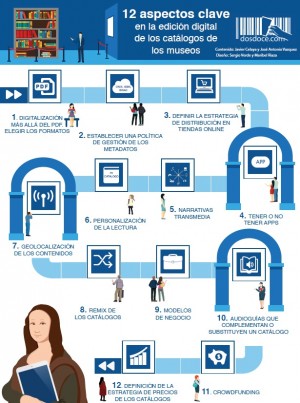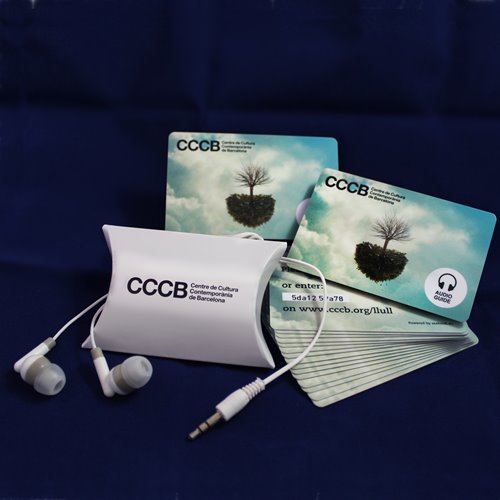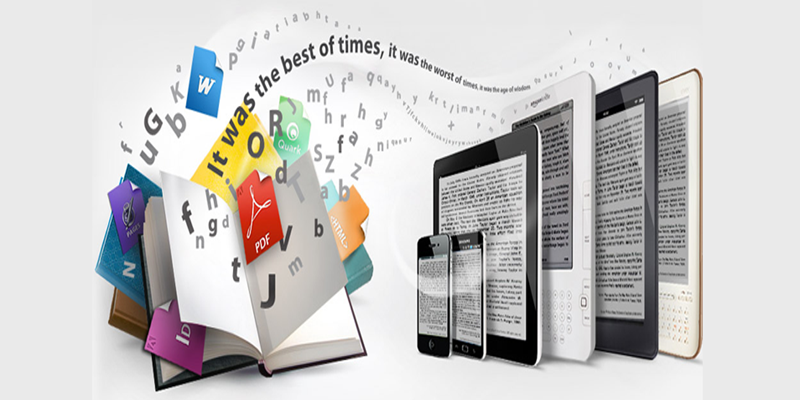Javier Celaya
Digital publishing provides a major opportunity for making our content more accessible to the public. With the holding of the Líber book fair this October in Barcelona a lot has been said about electronic publishing and distribution. Within this context, we have asked Javier Celaya for some hints and recommendations to activate digital publishing in museums. The following is an extract from his report 12 key aspects in digital publishing.
There is no digital field in which museums, irrespective of their size, are not innovating: new websites with responsive design, enriching the physical views for creating new experiences thanks to technology such as beacons, augmented reality, personalized apps, etc.
All of these initiatives reveal the real interest of these institutions –many of them with centuries of roots and importance in the cultural development of their countries, and of all the world- in accompanying the flow of the times (digital) in which we are currently immersed.
Nevertheless, within all of this updating there is an aspect in which it seems, rather surprisingly, that they don’t give much emphasis to. Here we are referring to the digital editions of their catalogues and publications. We say surprisingly because they have always played a very important role within the strategy of these entities, which take great care in their elaboration and publication in all the senses. The fact that they can now also be published in digital format signifies that they are a major opportunity for reaching more people anywhere.
There are good initiatives in museums throughout the world, although the trend isn’t yet mainstream. In 2007 the project OSCI (Online Scholarly Catalogue Initiative) had already begun, carried out by the Getty Foundation. This project of digital publishing was born with the aim of helping museums to make the transition from printed volumes to multimedia publications, of open access and free of charge. This initiative was joined by the Tate, the SFMOMA (San Francisco Museum of Modern Art), the LACMA (Los Angeles County Museum of Art), the Smithsonian or the Art Institute of Chicago, amongst others. The MET (Metropolitan Museum of Art) offers in its digital catalogue of publications the possibility of downloading in pdf, print-on-demand, or reading online. In Spain, the Fundación Juan March, with the project “All our art catalogues since 1973” not only offers its contents in a more agile and functional support, but it also constitutes an organised digital repository, with a system of advanced browsing and interconnected search throughout its portal and in each catalogue.
12 key aspects of digital publishing
With the aim of helping those in charge of this task in museums, we have developed 12 key aspects to take into account for all those institutions that decide to take a step forward and get involved in the digital publishing of their content.
- Digitisation beyond the PDF: the first step is to decide what content you want to digitise (collections, new catalogues, periodical publications). Some institutions have started taking the first steps with old collections, generally in PDF. Among these we can cite the Digital Library of the Museo del Prado. Unfortunately, the PDF format cannot be distributed in the main online shops of sale of the electronic books such as Amazon and Apple, and for this reason we recommend you convert the PDF into ePub format.
- Decide on the formats and establish a management policy of the metadata. Once you have decided what you want to digitize, the institutions should bear in mind which would be the most suitable ePub format (Fixed Layout, ePub2, ePub3, etc.). All of this would depend on whether you want to commercialise the catalogues, in which shops, and for which supports (tablets, mobiles, etc.). And managing the metadata well is key for the searchers, and therefore for making the content findable, that is, accessible.
- Define the distribution strategy. The institutions should distribute their catalogues and publications in the main shops of the world –it is the advantage of making a commitment towards the internationalisation; however, each of these platforms has its own conditions and particularities.
- Having apps or not. The apps are a highly suitable format for the content of specialised art publishers, but also a whole world in themselves due to the quantity of features. Many centres have started developing apps for their guides, but the possibilities are multiple given the nature of the support. The Guggenheim allows its publications to be downloaded in an app for iPad. The interactivity and the socialmobile, multimedia in general, or the possibilities of including gaming make the apps a very versatile format.

Infography: http://www.dosdoce.com/dosdoce-in-english/
- Transmedia Narratives. The content of a museum can be an ideal base for tackling transmedia initiatives, about everything from an educational point of view: the video-documentary format, social emdia, joined to an app and/or an eBook can signify various platforms from which they can show the narrative of the museum from the perspective of participation.
- Personalisation. The digital publishing of catalogues can allow the self-management of these, going as far as letting the reader end up publishing his or her own catalogue.
- Geolocalisation. Thanks once again to the apps, a digital catalogue can not only serve as something to be read before or after the visit, but also during the visit as a means of connecting with the museum thanks to technologies such as the beacons.
- Remix. One of the possibilities that the digital format has brought with it is the fragmentation of the content, opening up the possibility for the readers to be able to publish their own content based on different publications.
- Micropayment and pay-as-you-go. In the same way as the editor can opt for a model that remixes the contents, it can also be made possible for the readers to buy chapters or separate articles/essays from the catalogues, or, in those cases in which the they opt for reading online, to try out a model of pay-as-you-go.
- Audio-guides that complement the catalogue. Many museums are searching for different formulas for offering the content of the catalogues in audio-guide format that the visitors can take away with them at the end of the visit, such as the model of Seebook and Nubart from Digital tangible. The generalized use of the smartphones has opened up new possibilities when designing and creating audio-guides (which in reality are no longer necessarily limited to only being “audio”), allowing new approaches for each case.

Image: www.nubart.eu/audioguia/
- Crowdfunding. The campaigns for crowdfunding are not only useful for funding projects as we have seen in various cases in which works or restorations have been achieved, and which in the case of a catalogue can be particularly costly, but also for creating their own land which is suitable for the relation and inclusion of the visitors and the friends of the museum with the projects of the institution.
- Defining the pricing strategy of the catalogues and publications. Prior to initiating any of the previous points, the first thing is to design a strategy for not changing an idea each time that a new technology appears. The MOMA (Museum of Modern Art) offers an extensive catalogue of Books for sale.
We know the importance and tone, on occasions academic and scholarly, that some institutions give to the catalogues, but this isn’t a reason for being afraid of adapting to the new media, in the same way as they do when experimenting with new technologies for attracting new visitors, as well as offering new experiences for their users.
Javier Celaya
Founder of Dosdoce.com
Recommended links:
Genesis and process of the digital catalogues in the Fundación Juan March
The Guggenheim Puts 109 Free Modern Art Books Online
OSCI toolkit, tool for open source digital publishing developed by the IMA (Indianapolis Museum of Art)
Creative industries digital business models, Javier Celaya, 2015.








